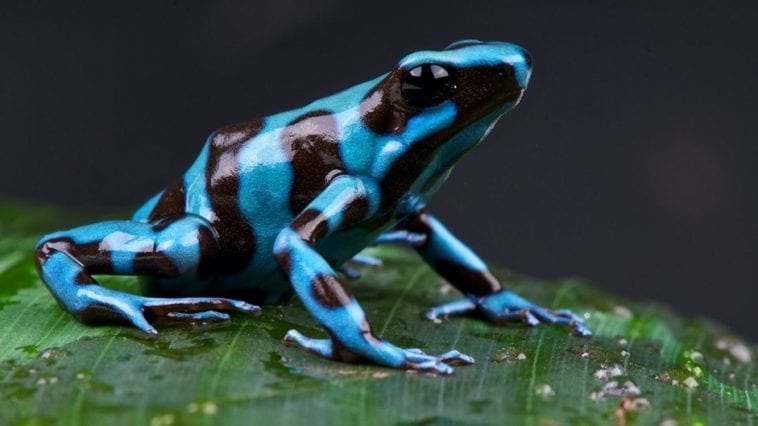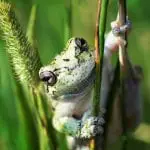A lot of different frogs are nice pets to have. That is because these tiny amphibians can look too cute with their large heads and huge eyes. They are also nice to observe if you enjoy looking at wildlife and how different animals interact with their surroundings. On top of that, there are some frogs that appear to be too colorful because of the different types of colors that adorn their skin.
However, what you should know here is that those bright and vivid colors hide a deadly secret that has taken the lives of many different predators in the course of the frog’s existence. There are plenty of frogs that carry skin that has all sorts of different colors that make them attractive to our eyes. But what you probably do not know is that what attracts our eyes is actually a sign for predators to stay away from these frogs as they can potentially die just by eating these amphibians.
Yes, that is right. There are a lot of colorful frogs that are actually poisonous amphibians. In most cases, the flashier and brighter the colors are, the more poisonous the frog actually is. That is why predators try to stay away from frogs that have bright and vivid colors as they are already naturally wired to know that they will only end up getting harmed if they tried to make a meal out of those frogs.
But, how dangerous are poisonous frogs? Well, we are here to find out.
What are poisonous frogs?
When it comes to poisonous frogs, there are different species of frogs that actually carry that poison we are talking about. You can put the Madagascar Mantella frogs in that category as these tiny and vividly colorful frogs carry a poison that can harm anything or anyone that tries to eat them. However, arguably the most popular poisonous frogs ever known to mankind are the Poison Dart Frogs.
The moment you hear the name “Poison Dart Frog,” fear might strike into your heart as you know for certain that these frogs have the potential to kill. However, what you should know is that these poisonous frogs are actually not capable of killing you just by darting at you. They are pretty similar to the Mantella frogs in terms of their colorful skin and their ability to poison predators willing enough to make a meal of them. However, you should know more about the Poison Dart Frog and other poisonous frogs before judging them.
Poison Dart Frogs are small frogs that are barely half an inch long even as adults. However, there are some that are able to grow to over two inches. Nevertheless, they are still regarded as small frogs. As a potential predator, you would instantly think that these frogs are quick snacks precisely because of how small they are and how quick they are to get eaten.
Nevertheless, what dissuades a predator from trying to attack the Poison Dart Frog are the vivid colors that adorn the body of the frog. These frogs are aposematic organisms that advertise how dangerous they are to predators just by being colorful. As such, they can feel confident enough to know that predators are naturally wired to think and believe that these frogs can harm them if they try to eat them. The colors on the Poison Dart Frog usually varies depending on the species and on the environment of the frog.
Poison Dart Frogs are usually found in Central and South America but are very popular in places such as Colombia, Brazil, Bolivia, Costa Rica, Venezuela, Nicaragua, Peru, and Panama. They inhabit tropical rainforests and are most likely to prefer humid and warm environments rather than dry or arid regions. That is why they are most likely found in Central and South America rather than in northern regions.
The Poison Dart Frog has a diet that is varied but is almost always based on insects and invertebrates. These frogs will eat any insect or invertebrate that is small enough to fit their mouths. In the wild, they have a more varied diet to the point that they will eat arthropods such as ants, mites, and centipedes. However, when kept in captivity, their diet is almost always restricted to the usual insect and invertebrate combination of roaches, crickets, mealworms, waxworms, and super worms. This is exactly why these frogs and other poisonous frogs tend to be “safer” when they are already living under captive conditions. But we’ll get to that later.
When you are planning on keeping a Poison Dart Frog as a pet, you should provide it with living conditions similar to most other amphibians that prefer to live under tropical conditions. That means that they should be housed in a warm yet humid habitat that has a good amount of water as frogs are amphibians that spend time on both land and water.
Why are poison frogs poisonous?

At this point, you might already be wondering why Poison Dart Frogs or other types of colorful and poisonous frogs are even poisonous to begin with. Well, you already know that their skin is the key when it comes to telling the entire world that they are poisonous. They might be attractive to our eyes, but these frogs are colorful precisely because they are poisonous.
The first thought that experts were able to come up with regarding the colorful skin of poisonous frogs is that this is their natural way of keeping themselves safe from predators. As aposematic amphibians, poisonous frogs advertise their unpalatable nature by simply being colorful. So, when a predator sees them and realizes how colorful these frogs are, they are immediately dissuaded from trying to make a meal out of them out of the fear that they will instead be doing harm to themselves if they try to eat these frogs.
In that sense, we can safely say that the poisonous and colorful nature of poisonous frogs such as the Poisonous Dart Frog is nature’s gift for them and is what allows them to have a natural means to survive in environments that are full of predators large enough to try to eat them when given a chance. But that does not exactly explain why they are poisonous.
When trying to know why these frogs are poisonous, we have to dig deeper and look at what their skin secretes. The skin of a Poison Dart Frog, for example, secrete toxins such as allopumiliotoxin 267A, batrachotoxin, epibatidine, histrionicotoxin, and pumiliotoxin 251D. These are alkaloids that are what chemically allow poisonous frogs to defend themselves from predators. But where do they come from?
It is believed by most scientists that poisonous frogs do not actually have the means to naturally produce such alkaloids. Instead, they actually get the chemicals from the food they eat and will excrete such chemicals through their skin in the form of the harmful alkaloids we previously mentioned. But what do Poison Dart Frogs eat that allows them to sequester such chemicals? We previously mentioned that, in the wild, these frogs would even eat arthropods such as ants and centipedes. Scientists believe that these are what provide the frogs with the chemicals that will become the base for the alkaloids they secrete through their skins.
So, are Poisonous Frogs Dangerous?

To answer that question, it is both a yes and a no. In a sense, poisonous frogs such as the Poison Dart Frogs are still dangerous in the sense that you should never try to eat them because of how the toxins might affect you adversely even after cooking them. But you must know that some species of poisonous frogs aren’t actually deadly but more likely to be harmful. They will cause nausea and paralysis when touched or ingested but will most likely not kill adult humans except if we are talking about the most poisonous of all Poison Dart Frogs.
In fact, some Poison Dart Frogs are so poisonous that the indigenous people of Colombia actually dip their blowgun darts in the secreted poison from these frogs whenever they are hunting. In that sense, you probably already understand why Poison Dart Frogs are named as such. It is the very fact that their skin secretes poison that allowed them to be dangerous enough to the point that they were used for hunting.
However, you should also know that poisonous frogs can actually be pretty safe. Of course, you are safe when you do not try to eat or touch these frogs as they are not venomous animals that will try to bite you and inject you with their venom. Instead, if you are simply looking at them, you won’t end up getting harmed. But there is actually more to that.
Going back to the diet of a Poison Dart Frog, it was observed that the toxicity in their alkaloid secretions decreased when they were already living under captive conditions. But why is that? Well, we look at the food they eat. Since poison frogs kept in captivity no longer eat a wide variety of insects that allow them to sequester chemicals used to produce toxic secretions, they are less likely to be dangerous when they are under captive care. That means that a diet of crickets and worms will not be enough to let allow them to produce harmful alkaloids. However, you should still be aware that poisonous frogs that have recently been caught are still pretty toxic. It might take a while for such frogs to get used to their diet under captive care before their toxicity decreases. So, does that mean that you can handle these frogs as long as they are already under captive care? Well, it still is not recommended not because they can harm you but because you could actually harm them. Frogs and other amphibians have skin that is so sensitive that they can easily get hurt when they get in contact with our hands. As such, it is still best to avoid handling or touching poison frogs. They are animals best left for us to observe and admire from afar than for touching and handling.



